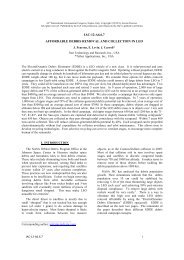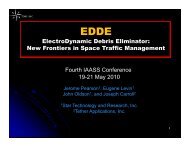The Cost of Future Collisions in LEO - Star Technology and Research
The Cost of Future Collisions in LEO - Star Technology and Research
The Cost of Future Collisions in LEO - Star Technology and Research
Create successful ePaper yourself
Turn your PDF publications into a flip-book with our unique Google optimized e-Paper software.
16<br />
<strong>and</strong> Ḣ1 <strong>and</strong> Ḣ2 are the decay rates at the altitudes H 1 <strong>and</strong> H 2 accord<strong>in</strong>g to (32). As<br />
all fragments from the layer dH 1 move to the layer dH 2 , the average spatial density<br />
<strong>of</strong> fragments changes from n 1 to n 2 , conserv<strong>in</strong>g the total number <strong>of</strong> fragments,<br />
n 1 dH 1 4πR 2 1<br />
= n 2 dH 2 4πR 2 2. (34)<br />
Tak<strong>in</strong>g <strong>in</strong>to account (33), relation (34) translates <strong>in</strong>to a curious “time-delayed”<br />
form <strong>of</strong> the cont<strong>in</strong>uity equation for the vertical flow <strong>of</strong> fragments,<br />
n 1 Ḣ 1 R 2 1<br />
= n 2 Ḣ 2 R 2 2. (35)<br />
If we disregard the change <strong>in</strong> the orbit radius compared to the change <strong>in</strong> the<br />
air density, we will arrive at a remarkably simple relation describ<strong>in</strong>g the long-term<br />
evolution <strong>of</strong> the fragment density,<br />
n 1 ρ a (H 1 ) ≈ n 2 ρ a (H 2 ). (36)<br />
For practical calculations, it is easier to <strong>in</strong>tegrate (32) backward <strong>in</strong> time, or<br />
use a “reverse” equation<br />
Ḣ = λ ρ a (H). (37)<br />
Now, we can calculate the density n at any altitude H <strong>and</strong> time t as<br />
n(H, t) ≈ n(H t , 0) ρ a (H t )/ρ a (H), (38)<br />
where H t is the altitude reached at time t along the solution <strong>of</strong> equation (37) with<br />
the <strong>in</strong>itial altitude H, <strong>and</strong> n(H t , 0) is the <strong>in</strong>itial density at the altitude H t at time<br />
t = 0. A typical solution <strong>of</strong> equation (37) for small fragments with b c ∼ 0.5 m 2 /kg<br />
is plotted <strong>in</strong> Fig. 8.<br />
Fig. 8. A typical altitude function for small fragments.








